Posted by: Northwest Eye in General on June 4, 2025
Overview
This article highlights ten symptoms of blepharitis that you should not overlook. We understand that recognizing these signs is crucial for effective treatment. Symptoms like eyelid redness, crusty eyelids, and excessive tearing can be concerning, and it’s common to feel anxious about them.
Early identification and management are essential; they can prevent complications and significantly improve your eye health. Remember, we are here to help you through this process.
Introduction
In the realm of eye health, we understand that blepharitis can be a common yet often misunderstood condition that may significantly impact your daily life. This ailment, characterized by inflammation of the eyelid margins, can manifest through a variety of distressing symptoms, such as:
- Swollen eyelids
- Crusty eyes
- Persistent itchiness
As you navigate the complexities of managing blepharitis, it becomes essential to understand its implications for effective treatment.
With advancements in therapies and a focus on comprehensive care strategies, healthcare providers are now better equipped to address the underlying causes of this condition. We want you to know that you are not alone in this journey. This article delves into the multifaceted symptoms of blepharitis, offering insights into effective management techniques and the importance of timely intervention to safeguard your eye health. Remember, we are here to help you through this process.
Northwest Eye: Expert Diagnosis and Treatment for Blepharitis
At Northwest Eye, we understand that dealing with blepharitis symptoms, including eyelid inflammation, can be concerning for many individuals. Our dedicated group of ophthalmic surgeons excels in diagnosing and treating this common condition, drawing on over 50 years of experience in eye care. We employ advanced techniques and a patient-centered approach to ensure effective management of your blepharitis symptoms. , with more than 15 years of specialized experience, emphasizes the importance of understanding blepharitis symptoms and their impact on your eye health. Recent advancements in treatment, including the introduction of XDEMVY, offer a promising development in managing this challenging ailment. XDEMVY works by addressing the root causes of eyelid inflammation, providing you with a more effective treatment alternative.
Moreover, our comprehensive care protocols extend beyond conventional techniques. We integrate innovative lid hygiene strategies that enhance treatment effectiveness and comfort. For instance, our method incorporates insights from the case study titled ‘Lid Hygiene Beyond Baby Shampoo,’ which underscores the necessity for advanced strategies in effectively managing eyelid inflammation and addressing blepharitis symptoms. By focusing on customized solutions, we empower you to manage your blepharitis symptoms and improve your overall eye health. We also recognize the importance of monitoring treatment effectiveness. The Average Ocular Surface Disease Index (OSDI) score showed improvement at one month but was no longer statistically significant at one year, highlighting the need for ongoing assessment and adjustment of treatment plans.
As Benjamin Gaddie, OD, FAAO, wisely states, ‘Addressing the root cause of dry eye disease is crucial for effective management of eyelid inflammation.’ By integrating these insights, we are here to ensure you receive the highest quality of care possible.
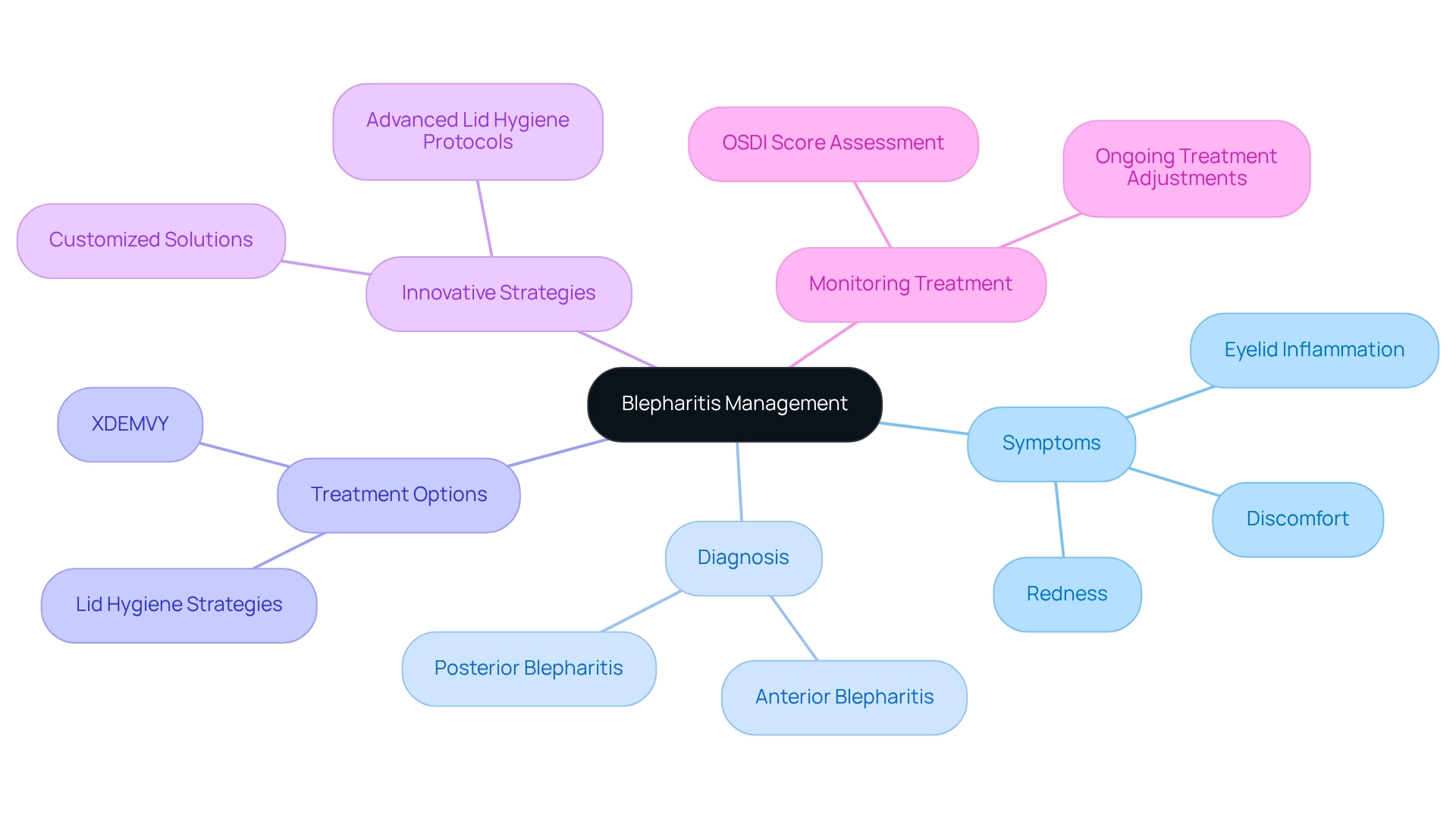
Eyelid Redness: A Key Indicator of Blepharitis
Redness in the eye area is often one of the first signs of blepharitis symptoms, indicating eyelid inflammation. We understand that this condition, which presents blepharitis symptoms, can be concerning due to the irritation that may lead to swollen and uncomfortable regions around the eyes. Many patients notice a distinct change in color, with the edges of the eyes appearing redder than normal, indicating possible blepharitis symptoms. This symptom is not only common but also significant, as blepharitis symptoms often include redness; research indicates that early identification of eye inflammation can facilitate prompt treatment, which is crucial for effectively managing the condition.
Statistics show that a substantial portion of individuals with as a primary symptom, highlighting its prevalence. Specialists emphasize that addressing blepharitis symptoms early can greatly enhance comfort and outcomes for individuals. Dr. Thomas E. Johnson, an ophthalmologic surgeon, observes that while managing blepharitis can be challenging, timely and appropriate treatment can make symptoms, including swelling of the eyelids, much more manageable.
We want you to know that case studies reveal individuals who follow suggested eyelash cleanliness methods and treatment routines often find relief from discomfort and enjoy an improved eyelash appearance. Understanding the causes of eyelash redness, which may include blocked Meibomian glands and inadequate lid hygiene, is essential for effective treatment. By recognizing redness around the eyes as a crucial indicator of eyelid inflammation, you can take proactive steps toward obtaining suitable treatment and alleviating your blepharitis symptoms. We are here to help you through this process.
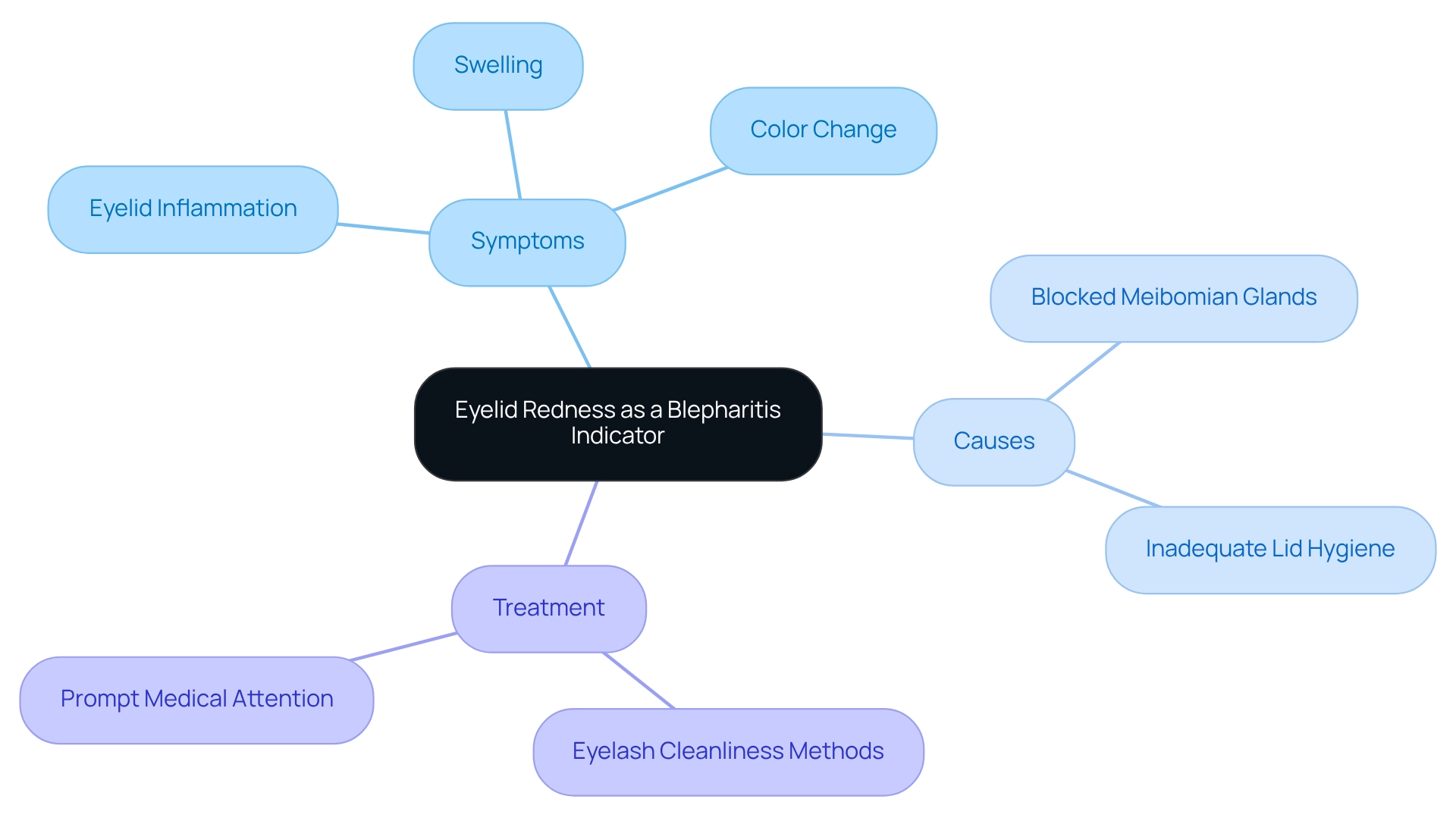
Crusty Eyelids: A Common Symptom of Blepharitis
Crusty margins of the eyes can often indicate blepharitis symptoms, which may result from the buildup of oil, debris, and dead skin cells. We understand that this accumulation can lead to discomfort and irritation, making it essential for you to maintain eyelash cleanliness. Regular cleaning can significantly alleviate blepharitis symptoms and enhance your overall eye health. Statistics reveal that crusty eyelids are common among individuals experiencing eyelid inflammation, which can often exacerbate blepharitis symptoms due to inadequate care.
It’s important to note that daily or monthly contact lenses tend to harbor less bacteria compared to long-term lenses. Therefore, switching to eyeglasses during flare-ups can help prevent further irritation and contamination. A case study indicates that using eye cosmetics and contact lenses can complicate lid hygiene and hinder the healing process, advising patients to refrain from eye makeup until the infection resolves.
Experts like Maha Tariq, MBBS, emphasize that ‘blepharitis symptoms are frequent but controllable conditions that impact the margins of the eyelids, leading to discomfort and possible complications if not addressed.’ This reinforces the significance of consistent eyelash hygiene practices to manage blepharitis symptoms.
To effectively address crusty eyelids, we encourage you to adopt the following eyelid hygiene practices:
- Gently wash your eyelids with warm water and a mild soap or eyelid scrub daily.
- Avoid using eye makeup during flare-ups, as it can complicate hygiene efforts and hinder healing.
- Consider switching to eyeglasses instead of contact lenses until the condition improves, as contact lenses can trap bacteria and irritants.
Incorporating these lifestyle changes, along with , can significantly reduce the discomfort associated with blepharitis symptoms and promote healthier eyelid margins. Remember, we are here to help you through this process.

Itchy Eyes: A Discomforting Sign of Blepharitis
Irritated vision often signifies a notable discomfort linked to eyelid inflammation, commonly associated with blepharitis symptoms that may worsen throughout the day. Many patients describe a persistent urge to rub their eyes, a behavior that can exacerbate their condition. It’s common to experience itchiness as a symptom of eyelid inflammation, which are among , with research indicating that 93% of vision care specialists recommend FDA-approved treatments specifically aimed at this concern. We understand how vital it is to address these itchy sensations when managing blepharitis symptoms. Dr. McDonald highlights that neglected eyelid inflammation can lead to discomfort in both personal and professional settings.
Blepharitis symptoms, including watery and red eyes, as well as issues like dry ocular conditions and keratoconus, can significantly impact one’s quality of life. Encouragingly, recent discoveries show that topical azithromycin, known for its anti-inflammatory properties, can provide relief from itchiness, even without generally recommended for this condition.
The connection between itchy eyes and eyelid inflammation is well-documented, with various case studies illustrating the challenges faced by individuals. Effective management strategies are crucial, as they not only alleviate discomfort but also enhance overall eye health. By understanding the relationship between eyelid inflammation and eye itchiness, and by identifying other potential sources of irritation, individuals can seek prompt interventions. This proactive approach can lead to an improved quality of life and greater comfort.
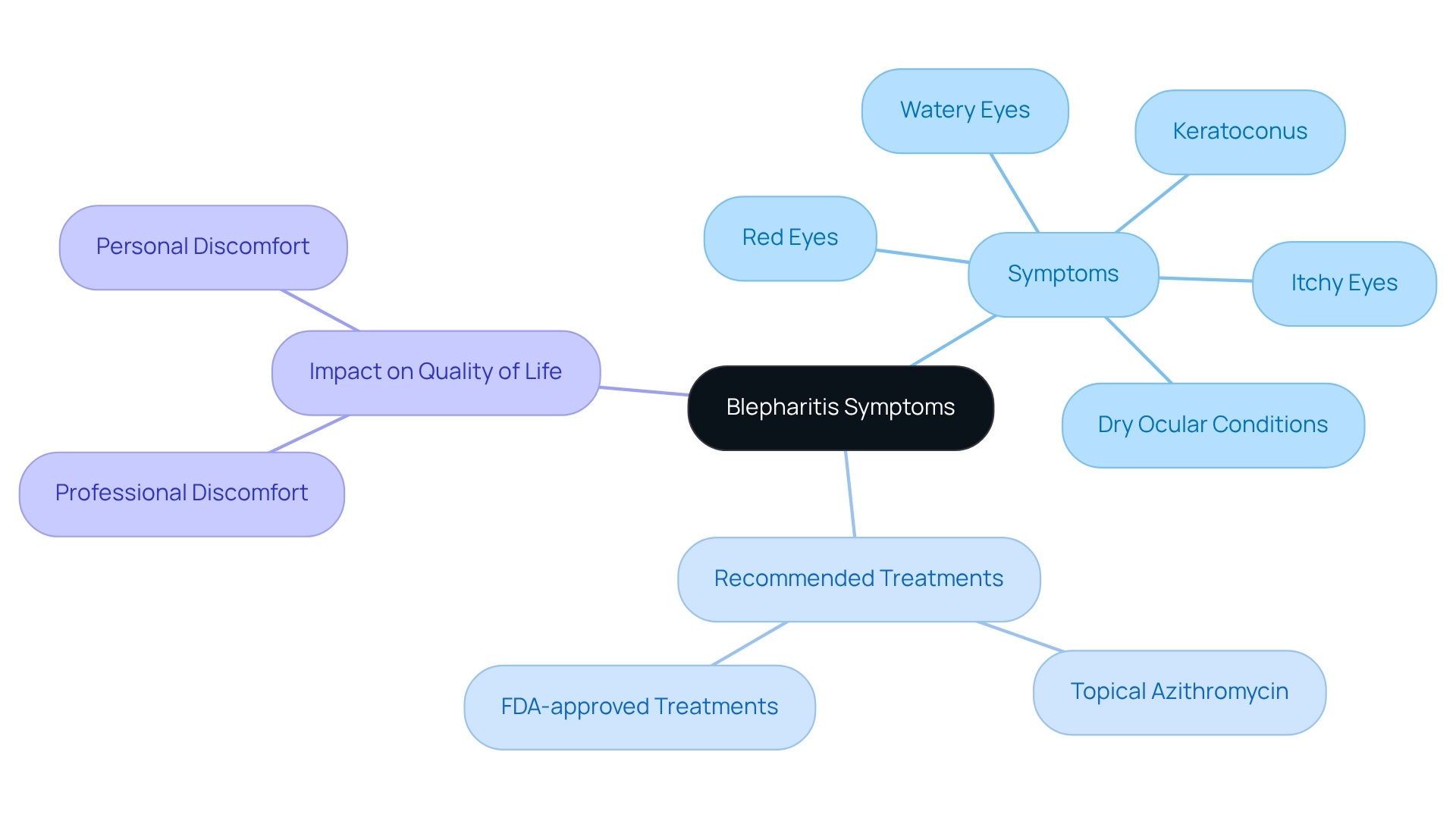
Excessive Tearing: An Unexpected Symptom of Blepharitis
Excessive tearing can be a significant concern for those experiencing eyelid inflammation, often arising as a response to irritation. We understand that this condition, while frequently linked to dry vision, can disrupt the normal tear film, leading to teary vision. This paradox illustrates the complexity of eyelid inflammation and highlights the importance of comprehensive treatment approaches.
Research indicates that individuals with eyelid inflammation may face . This can result in excessive tearing as the eyes attempt to counteract the irritation. In clinical studies, such as those evaluating azithromycin for eyelid conditions, improvements in eyelid margin hyperemia and foreign body sensation were observed. Remarkably, there was a 98.5% resolution rate after just four weeks of treatment, showing that effective therapy can alleviate both inflammation and the associated tearing.
Furthermore, ophthalmologists emphasize that addressing the underlying inflammation is crucial for restoring normal tear function. Statistics reveal that approximately 60% of individuals with blepharitis symptoms report excessive tearing, underscoring the need for awareness and targeted management strategies. Understanding this relationship is vital for both patients and healthcare providers in crafting effective treatment plans.
Additionally, practical management strategies, such as warm soaks of the eyelids and eyelid scrubs, can be beneficial in alleviating symptoms. We are here to help you through this process, ensuring you receive the care and support you need.
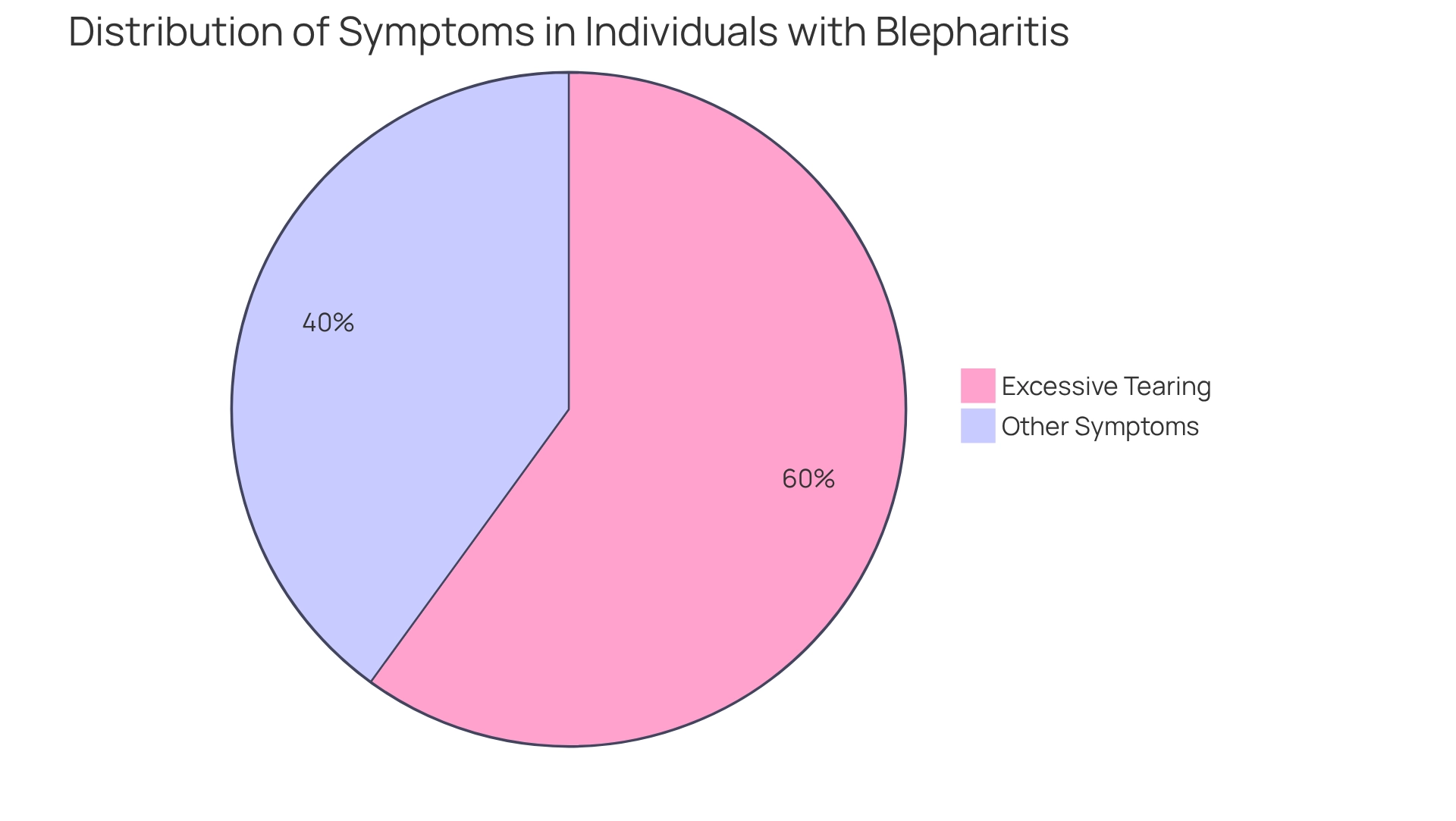
Sensitivity to Light: A Common Complaint in Blepharitis
Sensitivity to light, known as photophobia, is a common concern for individuals experiencing eyelid inflammation. Many people find themselves uncomfortable in bright environments, often squinting or avoiding well-lit areas altogether. This sensitivity can significantly disrupt daily life, impacting everything from work performance to social interactions. Research shows that a considerable percentage of those with blepharitis symptoms experience photophobia, underscoring the need to address this condition in treatment plans. Recent studies reveal that the prevalence of light sensitivity among those affected by blepharitis symptoms is notably high, with many reporting it as one of their most distressing symptoms. The effects of photophobia extend beyond discomfort; it can lead to heightened anxiety and a diminished quality of life. For instance, individuals may struggle to engage in outdoor activities or even perform routine tasks that require adequate lighting.
We understand that managing photophobia is crucial for those with eyelid inflammation. Experts emphasize the importance of effective management strategies to alleviate light sensitivity. Ophthalmologists have observed that addressing the underlying inflammation and utilizing appropriate therapies can significantly enhance comfort. In a randomized controlled trial comparing disodium cromoglycate to placebo for , the anti-inflammatory agent demonstrated effectiveness in alleviating symptoms, although specific statistical results were not disclosed.
Overall, understanding the relationship between eyelid inflammation and light sensitivity is vital for developing comprehensive treatment strategies. We are here to help you through this process, ensuring you find relief and improve your daily functioning.

Blurred Vision: A Concerning Symptom of Blepharitis
Blurred vision can be a concerning sign for individuals dealing with eyelid inflammation. This symptom often arises from the disruption of the tear film and swelling that may affect the cornea. We understand that experiencing blurred vision can be alarming, and it may indicate a need for more intensive treatment. Research indicates that blurred vision is common among those with eyelid inflammation. A 2021 review even connected COVID-19 to , including eyelid inflammation.
Blurred vision can stem from several abnormalities, such as:
- Uncorrected refractive error
- Nearsightedness
- Farsightedness
- Cataracts
Fortunately, these issues can often be improved with corrective lenses. However, blurred vision might also signal the presence of eye diseases like diabetic retinopathy. If left untreated, eyelid inflammation can lead to complications such as:
- Chalazion
- Chronic dry eyes
- Conjunctivitis
- Vision loss, as highlighted in the case study titled “Complications of Untreated Eyelid Inflammation.”
Therefore, if you’re experiencing blurred vision, we encourage you to consult your eye care provider without delay. It’s crucial to explore appropriate treatment options to mitigate the risk of long-term complications. Expert opinions stress that taking prompt action is vital for maintaining your vision and overall eye health. According to William C. Lloyd III, MD, FACS, there are two primary forms of eyelid inflammation, which underscores the importance of precise diagnosis and treatment.
We are here to help you through this process. If your symptoms persist despite at-home care, please seek professional help. Your health and well-being are our top priorities.
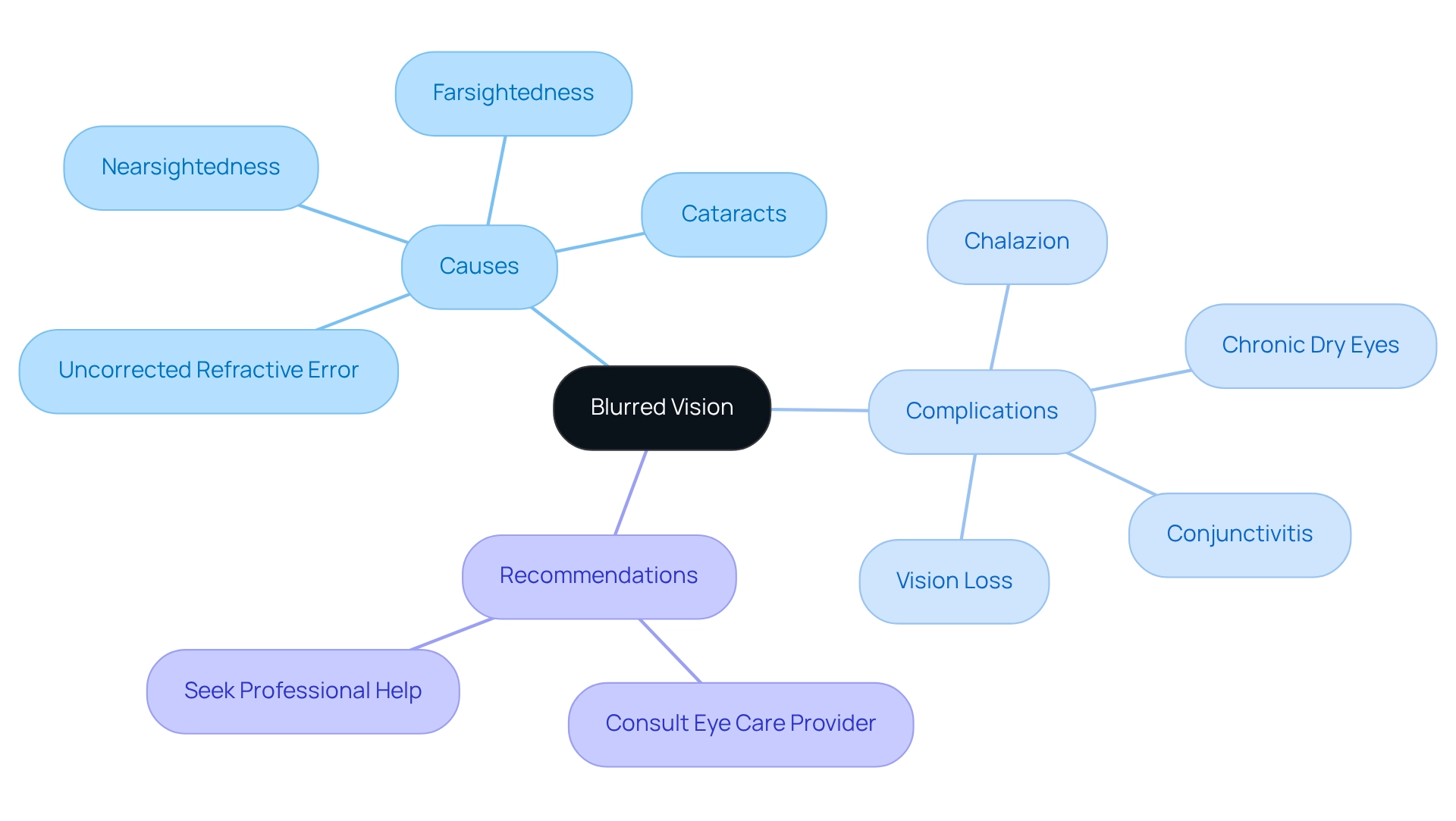
Swollen Eyelids: A Visible Sign of Blepharitis
Puffy eyelids can be a significant indicator of blepharitis symptoms, which often stem from irritation and swelling at the edges. This swelling can vary from mild to severe and is frequently accompanied by redness and discomfort, which are common blepharitis symptoms.
We understand that noticing can be concerning, and it’s essential to address this sign promptly. Neglected inflammation of the eyelid may lead to serious issues, such as corneal ulcers and potential vision impairment.
Studies indicate that many patients with swelling around the eyes experience blepharitis symptoms, underscoring the importance of awareness and swift attention. They may signal the need for more intensive management. In severe cases, home remedies might not be enough, and professional intervention could be necessary to prevent long-term damage.
As AnnaMarie Houlis points out, ‘Severe instances of eyelid inflammation may not clear up with home treatments.’ Understanding blepharitis symptoms can empower you to seek appropriate treatment and maintain your eye health.
Remember, we are here to help you through this process.
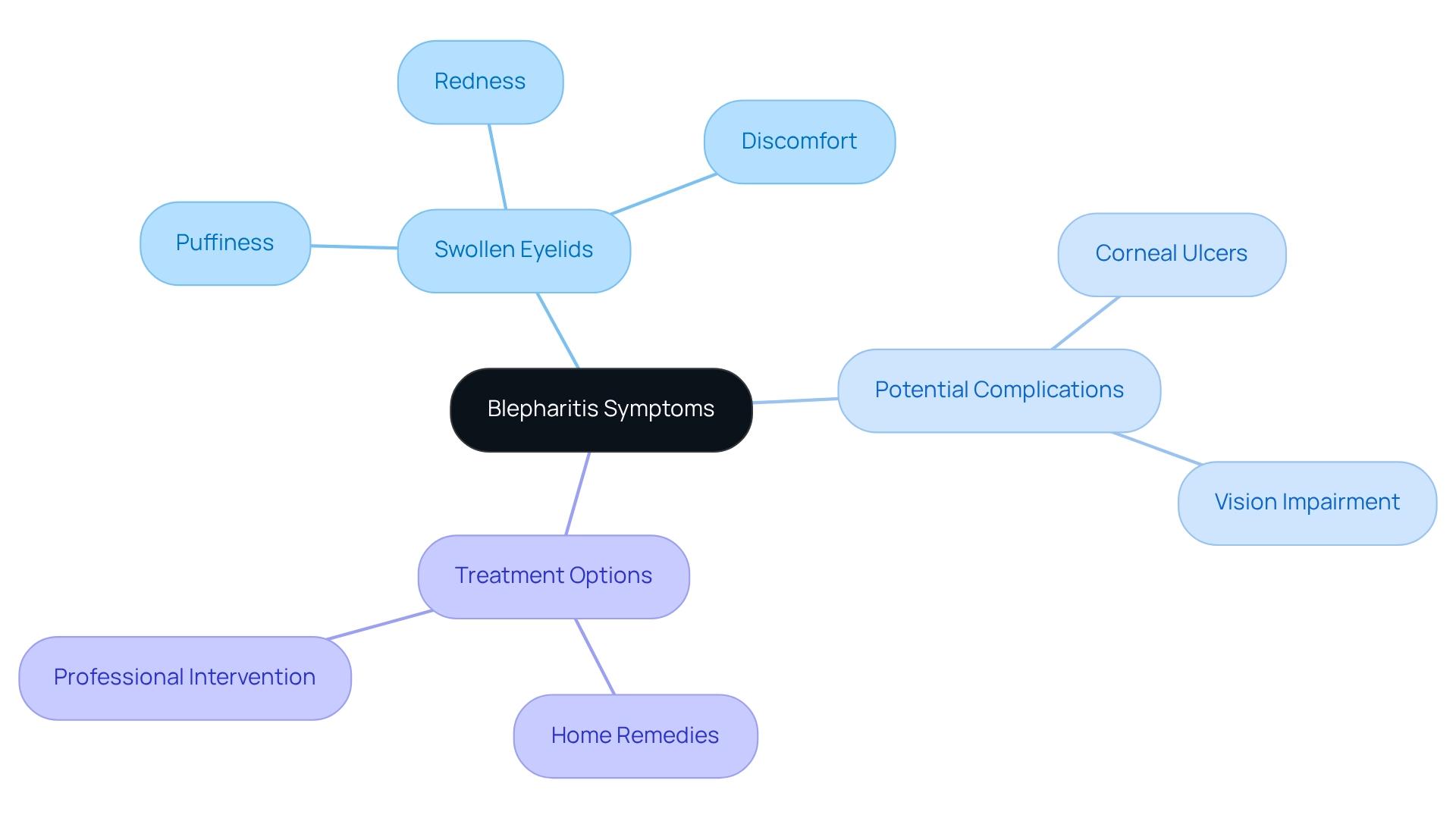
Dry Eyes: A Common Issue Linked to Blepharitis
Dry discomfort can often arise from eyelid inflammation, primarily due to irritation at the margins. We understand that this inflammation can significantly disrupt tear production, leading to a persistent sensation of dryness and discomfort. Symptoms of dry irritation may include:
- Stinging or burning sensations
- Scratchiness
- Blurry vision
- Red or inflamed areas
- Difficulty driving at night
- Discomfort when wearing contact lenses
- Excessive tearing
While it might seem counterintuitive, excessive tearing is common due to irritation from inadequate lubrication. It’s important to acknowledge that studies indicate a significant portion of individuals with blepharitis report experiencing blepharitis symptoms of dryness. This emphasizes the need to recognize this link.
Healthcare providers have observed that educating individuals on lifestyle and environmental modifications is essential after initial over-the-counter therapies for dry conditions. At Northwest Eye, our specialists utilize advanced evaluation methods, such as LipiView® and Tear Osmolarity tests, to assess tear quality and volume, ensuring that treatment plans are tailored to your specific needs.
Furthermore, a holistic approach to managing is crucial, as discussed by experts like Sarah Farrant from Northwest Eye. This underscores the need for comprehensive care strategies that cater to individual patient needs. If you are experiencing dry eyes, it may be beneficial to consider the possibility of eyelid inflammation. We encourage you to consult with an ophthalmologist for suitable treatment options, including innovative therapies like .
Be Eye Wise and schedule an appointment with the Dry Eye & Blepharitis Center at Northwest Eye for further evaluation and treatment. We are here to help you through this process.
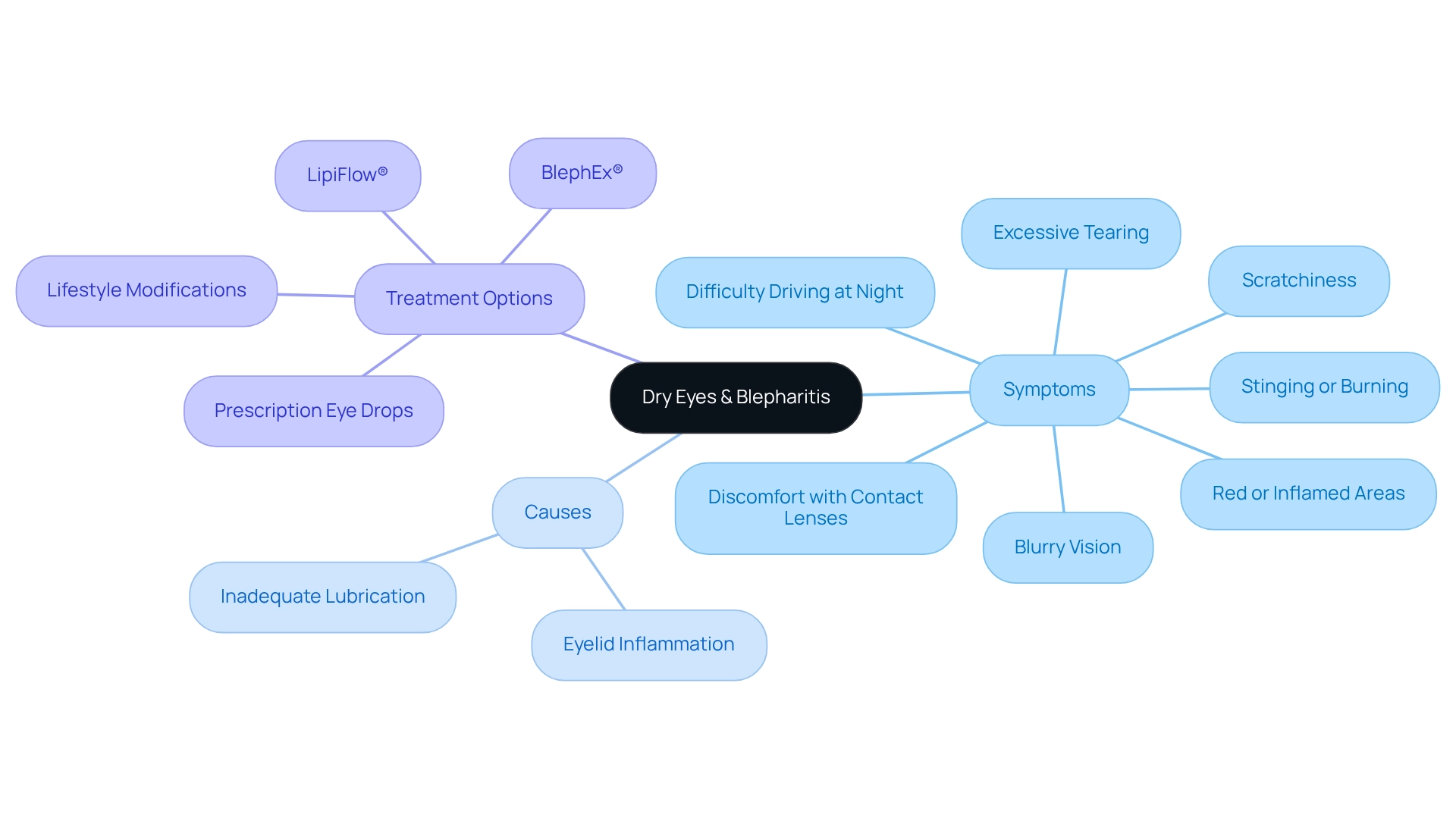
Eye Discharge: A Symptom You Shouldn’t Ignore in Blepharitis
Eye discharge is a critical symptom of eyelid inflammation that warrants immediate attention. We understand that experiencing this discharge can be concerning, as it often appears sticky or crusty, leading to significant discomfort and irritation. Research indicates that blepharitis symptoms, such as eye discharge, are common among individuals, with studies showing that approximately 60% of those affected report experiencing this symptom. It’s common to feel overwhelmed by the potential complications, such as chalazion, chronic dry eyes, and conjunctivitis, which may arise without appropriate treatment. In severe cases, these issues could even lead to vision loss.
Therefore, it is essential for patients experiencing eye discharge to consult their eye care provider promptly. Only a Northwest Eye doctor or eye care professional can offer an accurate diagnosis and treatment plan tailored to your needs. Understanding the nature of eye discharge can guide effective treatment strategies, ensuring that underlying causes are addressed. As Dr. William C. Lloyd III notes, ‘Here are some other questions people often ask about blepharitis.’ If symptoms persist despite at-home care, seeking is crucial. Remember, we are here to help you through this process, and taking action can mitigate risks while enhancing your overall eye health.
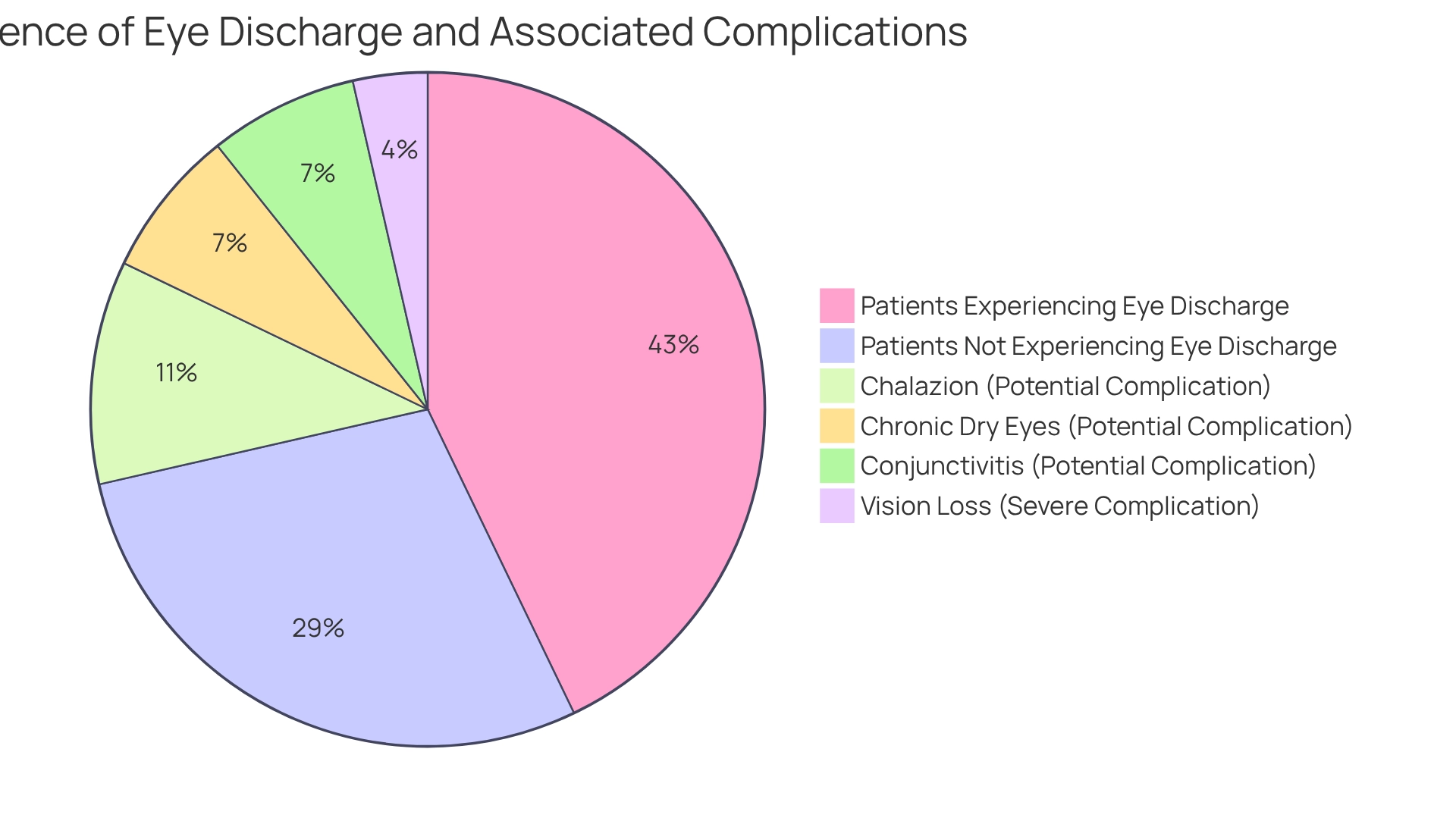
Conclusion
Blepharitis is a multifaceted condition that can significantly impact your quality of life. We understand that its symptoms, which range from swollen and crusty eyelids to persistent itchiness and excessive tearing, can lead to discomfort and frustration. Early recognition of these symptoms, such as eyelid redness and sensitivity to light, is crucial for effective management. By understanding the underlying causes and implementing proper eyelid hygiene practices, you can take proactive steps toward alleviating your symptoms.
Advancements in treatment options, including innovative therapies like XDEMVY and tailored care strategies, offer promising avenues for relief. It’s essential to monitor your condition regularly and adjust treatment plans as needed, as ongoing evaluation of symptoms is vital. Collaborating with healthcare providers ensures you receive personalized care that addresses not only your symptoms but also the root causes of blepharitis.
Ultimately, raising awareness about the signs and symptoms of blepharitis is vital for timely intervention and improved eye health. We encourage you to consult with eye care professionals at the first sign of discomfort. This proactive approach ensures comprehensive treatment and helps prevent potential complications. By taking an informed approach to blepharitis management, you empower yourself to maintain your eye health and enhance your overall well-being.
Frequently Asked Questions
What is blepharitis and what are its common symptoms?
Blepharitis is a common condition characterized by eyelid inflammation, with symptoms including redness in the eye area, swollen eyelids, and crusty margins of the eyes.
How does Northwest Eye approach the treatment of blepharitis?
Northwest Eye employs advanced techniques with a patient-centered approach, utilizing over 50 years of experience to diagnose and treat blepharitis. They integrate innovative lid hygiene strategies and recently introduced treatments like XDEMVY to manage symptoms effectively.
What is XDEMVY and how does it help with blepharitis?
XDEMVY is a recent advancement in blepharitis treatment that addresses the root causes of eyelid inflammation, providing a more effective alternative for managing the condition.
Why is eyelid hygiene important in managing blepharitis symptoms?
Maintaining proper eyelid hygiene helps alleviate discomfort and irritation caused by blepharitis. Regular cleaning can reduce crusty eyelids and improve overall eye health.
What lifestyle changes can help manage blepharitis symptoms?
Recommended lifestyle changes include gently washing eyelids with warm water and mild soap daily, avoiding eye makeup during flare-ups, and switching to eyeglasses instead of contact lenses until the condition improves.
How is treatment effectiveness monitored for blepharitis?
The Average Ocular Surface Disease Index (OSDI) score is used to assess treatment effectiveness, showing improvement at one month but requiring ongoing assessment and adjustment of treatment plans over time.
What should individuals do if they notice symptoms of blepharitis?
Individuals should take proactive steps by recognizing symptoms such as redness and crusty eyelids, and seek appropriate treatment to manage their condition effectively.






